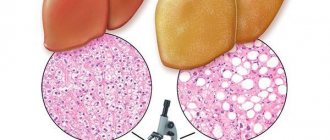The danger is posed by small, up to 3-5 nm, microparticles of quartz and cristobalite. When the permissible concentration of harmful substances in the air is exceeded, fine dust settles on the bronchi and alveoli of the lungs. If workers do not use personal protective equipment and inhale harmful substances for a long time, then after 2-3 years of work, pulmonary silicosis develops.
There are several types of disease based on the speed of development:
- acute;
- chronic;
- progressive;
- accelerated view.
What form the pathology takes depends on the time of exposure to industrial dust, its intensity, the general condition of the body and the presence of concomitant diseases. Clinical and morphological forms of silicosis are defined as:
- nodular;
- multiple sclerotic;
- combined.
The acute form of fibrosis progresses even after stopping contact with dust. In general, treatment gives a favorable prognosis.
Symptoms of silicosis
Symptoms of stage 1 silicosis:
- shortness of breath on exertion;
- coughing;
- loss of appetite;
- chronic fatigue;
- chest pain.
Symptoms of stage 2 silicosis:
- shortness of breath with little physical exertion;
- increased cough;
- constant chest pain;
- rapid breathing at rest;
- hard breathing;
- dry wheezing.
Symptoms of stage three silicosis:
- severe shortness of breath;
- painful cough with sputum production;
- attacks of suffocation;
- multiple dry wheezing;
- foci of wet rales;
- tachycardia (increased heart rate);
- dysfunction of the gastrointestinal tract;
- severe and frequent headaches.
If you experience similar symptoms, consult your doctor
. It is easier to prevent a disease than to deal with the consequences.
Diagnostics
When the first signs of malaise and respiratory problems appear, you must immediately make an appointment with a general practitioner or occupational pathologist. The specialist will conduct a consultation and initial examination and, if necessary, prescribe the following diagnostic studies: chest x-ray, ultrasound of the sternum, determination of the vital capacity of the lungs and their maximum ventilation, forced expiratory volume, identification of the respiratory rate and the maximum speed of the air stream during exhalation.
Treatment of silicosis
Treatment of silicosis involves taking the following measures:
- avoiding contact with silicon dust;
- oxygen inhalation;
- breathing exercises;
- bronchoalveolar lavage (introduction of a neutral solution into the bronchi and lungs);
- taking bronchodilators, expectorants;
- taking antibacterial drugs;
- immunostimulants and adaptogens;
- surgical intervention.
Unfortunately, silicosis cannot be completely cured. However, if a person consults a specialist at an early stage of the disease, then the progression of the disease can actually be stopped.
Why does the disease occur?
The main cause of the disease is inhalation of dust, which contains:
- silicon dioxide (quartz);
- silicates;
- talc.
Workers in the following professions are susceptible to pathology:
- miners;
- glass blowers;
- miners;
- potters;
- sandblasters;
- stone carvers;
- quarry workers, etc.
The speed and severity of the disease development depend on several factors:
- The disease develops more severely and quickly when inhaling the free crystalline form of silicon than the bound form.
- The duration and strength of the influence of the causative factor influences. The longer a person's contact with high dust conditions lasts and the higher the concentration of silicon in the air, the faster the pathology develops.
- The more time has passed since the dust has been crushed, the less aggressive it is.
- Uncoated silica particles cause pulmonary silicosis more quickly.
Prevention
Prevention of silicosis involves the following actions:
- carrying out anti-dust measures;
- use of personal protective equipment against dust;
- shortened working hours for people working in risk areas;
- early retirement;
- consumption of dairy products, which contribute to the rapid removal of harmful substances from the body;
- regular preventive examinations by specialists. a pulmonologist
twice a year . - treatment and recovery in a sanatorium.
This article is posted for educational purposes only and does not constitute scientific material or professional medical advice.
How does it manifest?
There are two forms:
- chronic - occurs most often;
- acute - develops as a result of intense influence of the causative factor over a short period, 1–2 months.
Chronic silicosis occurs for a long time without clinical manifestations. The first symptom is shortness of breath. At the initial stage, it occurs during intense work, and then appears at rest. The cough comes later, when the bronchi are involved in the pathological process. Smoking intensifies it.
Over time, as the disease progresses, respiratory failure develops, which leads to heart pathology.
Patients experience chronic hypoxia (lack of oxygen) in the following manifestations:
- fatigue;
- earthy complexion;
- fingers like drumsticks;
- weight loss;
- persistent dry cough;
- chest pain;
- decreased breathing;
- flattening of the nail plate and its acquisition of the shape of watch glasses;
- decreased performance.
Acute silicosis manifests itself in the same way, the only difference is the rate of progression of symptoms. If in the chronic form respiratory failure develops over decades, then in the acute form it takes just 1–2 years.
Forecast[edit]
Silicosis can cause serious problems not only in the lungs, but also in the heart. The disease tends to progress even after stopping work in conditions of exposure to dust containing silicon dioxide. The risk of progression increases when, after silicosis is diagnosed, the worker continues to work in a dusty atmosphere; and also in the case when the employee continues to work in a non-polluted atmosphere - performing heavy physical work. To a lesser extent, the continued development of silicosis can be facilitated by pneumonia, poor nutrition, and exposure to irritating gases[19]. Silicosis is often complicated by pulmonary tuberculosis, which leads to a mixed form of the disease - silicotuberculosis.
Causes of pulmonary dissemination
When dissemination is detected in the lungs, it is important to accurately determine the cause and identify the specifics of the pathological process. The causes of pathological processes, depending on the shape, density and nature of the distribution of lesions, can be:
- Tuberculosis;
- Pneumonia;
- Poisoning by toxic gases and drugs;
- Prolonged inhalation of industrial dust (pneumoconiosis);
- Hamman-Rich disease;
- Other types of alveolitis (including allergic);
- Goodpasture's syndrome;
- Idiopathic pulmonary fibrosis;
- Oncological diseases of the lungs or other organs (sarcoidosis, metastases, carcinomatosis, bronchoalveolar cancer);
- Acute respiratory distress syndrome;
- Vasculitis (including rheumatoid);
- Some diseases of other internal organs (heart, liver).
Note that the causative agents of infectious and inflammatory lung diseases that can cause disseminated lung damage include a large group of viruses, bacteria and fungi (mycobacterium tuberculosis, SARS-CoV-2, coccidioides immitis), etc. Sometimes it is possible to identify the exact cause of diffuse inflammatory foci and fibrosis is not possible. If the disease has symptoms similar to tuberculosis or pneumonia, or there is severe fibrosis, but even after medical examinations the cause remains unclear, then such pathological changes are called “idiopathic”, and treatment tactics are selected individually based on the data obtained and the patient’s medical history.
Therefore, disseminated lung diseases are considered quite difficult to diagnose. CT scan of the lungs is much more informative than conventional radiography, however, even this method, isolated from laboratory tests, does not provide enough information to prescribe therapy. If a pulmonologist or radiologist suspects a malignant process, a biopsy may be recommended for the patient.
Complications
The disease is often accompanied by complications, which can make diagnosing silicosis difficult . Against the background of inhalation of silica, the following may develop:
- obstructive bronchitis;
- pneumonia;
- bronchial asthma;
- bronchiectasis;
- spontaneous pneumothorax;
- malignant neoplasms.
Autoimmune processes provoke the development of rheumatoid arthritis. The addition of mycobacteria causes tuberculosis.
Treatment[edit]
Silicosis is incurable and irreversible
:
There are currently no effective treatments for pulmonary fibrosis, including silicosis.[13]
But the patient’s condition can be improved, so that in some cases he will be able to work, live longer, and his life will be more fulfilling.
The lung of a miner who suffered from silicosis and tuberculosis.
When treating patients with silicosis, the main attention should be paid to measures aimed at reducing the deposition of dust in the lungs, removing it from there and slowing down the development of the fibrotic process in the lungs. At the same time, measures are taken to increase the (general) resistance of the body, increasing pulmonary ventilation and blood circulation. To do this, use [4]:
- Alkaline and salt-alkaline inhalations. This activates the work of the integumentary tissues of the mucous membrane of the respiratory tract, dilutes the mucus on them, and thus promotes the (only partial) removal of dust. Use a 2% sodium bicarbonate solution - one session per day lasting 5-7 minutes at an optimal aerosol temperature of 38-40°C; per course - 15-20 sessions. Alkaline and calcium mineral waters can be used as an aerosol.
- If silicosis is not complicated by tuberculosis, physiotherapeutic methods are used to slow down the fibrotic process in the lungs: irradiation of the chest with ultraviolet rays and a high-frequency electric field (UHF). It is believed that ultraviolet rays increase the body's resistance, and UHF increases lymph and blood flow in the pulmonary circulation. This affects the removal of dust and slows down the development of pneumoconiosis. It is better to carry out ultraviolet irradiation 1-2 times in winter (November-February) every other day or daily; 18-20 sessions per course. when using UHF electrodes are placed frontally: one in front - above the upper chest, at a distance of 4 cm from it, and the other - respectively behind. On the sides, electrodes are placed over the axillary areas of the chest on both sides. UHF irradiation is carried out every other day, the duration of the procedure is 10 minutes; 10 sessions per course.
When silicosis is complicated by chronic bronchitis, bronchial asthma, cor pulmonale, or chronic inflammatory processes in the lungs, the corresponding diseases are treated (without silicosis).
Patients with silicotuberculosis are actively treated for tuberculosis, taking into account the tolerability of anti-tuberculosis drugs. Silicosis complicates the treatment of tuberculosis.
In the first and second stages of silicosis, patients can be sent to sanatorium-resort treatment.
In the Russian Federation, due to the deterioration of medical care for miners, the situation with their occupational diseases is very negative[14]
According to some data, the use of drugs (polyvinyl oxides) can delay the development of the silicotic process in the lungs of experimental animals[15]. But testing of drugs of this type (in the USSR[16]) did not lead to their use for treating people. Academician Velichkovsky B.T. believed[17] that a more in-depth (repeated) study of such drugs should be carried out; and take into account the fact that they are already used for treatment (inhibiting the development of the disease) in some countries, for example, in China. He noted that a similar drug (polyoxidonium) is so low-toxic that its use (for other purposes) is permitted. And according to [18], this drug is not suitable for people.
| ◄ ► |
Silicotic nodules, stage I-II pneumoconiosis
Silicotic nodules, connective tissue changes
Anthracosilicosis stage I
Anthracosilicosis stage I, interstitial form, right-sided chronic pneumonia
Anthracosilicosis stage I-II, right-sided chronic pneumonia
Stage II silicosis, bilateral chronic pneumonia
Silicosis stage II-III
Siderosilicosis stage III
Siderosilicosis stage II, miliary pulmonary tuberculosis






